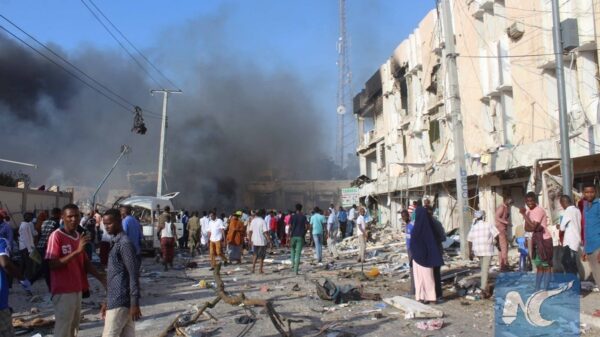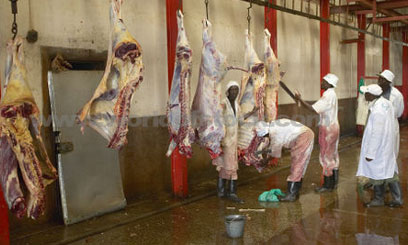NAIROBI, Kenya, Aug 1- The overwhelming stench of solid waste and effluent was blown over a radius of almost two kilometres away from the slaughterhouse.
As if this was not enough, toxic effluent consisting of blood and fecal matter was channelled to a nearby stream, which is a tributary of Nairobi River, threatening millions of city residents with water borne diseases and endangering the environment.
For contravening environmental regulations, Dagoretti’s Nyongara Slaughter House was slapped with a six-month closure by the National Environment Management Authority (NEMA).
Within no time, hundreds of workers who depend on the Slaughter House for their livelihoods were staring poverty in the face.
“We were closed down by NEMA and the main purpose was for us to take care of the waste because it was a hindrance to the community here as it used to flow into the nearby Kabuthi River,” the abattoir’s Administration Assistant Kennedy Ababu admitted.
However, the six conditions that they had to meet before the Authority allowed them to resume operations were not easy to implement nor were they affordable.
“The cost of curing, the cost of managing the waste became a very big problem. To exhaust a lorry of effluent cost Sh10,000 and we were to exhaust about 15 lorries in a month. This was a real cost,” he explains.
This was a daunting task for a facility that slaughters an average of 100 cows per day, and it therefore served as a wake up call for the abattoir’s board and management.
They needed to devise a plan that could help them turn the waste generated there into something useful. That is how Dagoretti’s Nyongara Slaughterhouse Biogas project was born.
The initiative brought together several public and private sector institutions including Kenya Industrial Research and Development Institute, (KIRDI), UNEP and United Nations Industrial Development Organisation and in 2009, the partners launched the pilot project.
Chrispine Onyango a researcher at KIRDI and the biogas Project Manager explains the complex process.
“We have the waste that mainly comes from the slaughterhouse and it’s the main feedstock for the biogas plant. Every day, we feed the stomach content, the meat particles and the cow dung in the hydrolysis tank where a chemical reaction takes place,” he says.
The mixture of the solid and liquid waste which, in technical terms, is called the slurry is then injected into another tank called a main digester.
After the breakdown of these components, electricity, gas and a nutrient-rich digestate that can be used as fertiliser.
From just 300 kilograms of waste per day, 9KWh of electricity is produced. For the management, this is a welcome initiative that has enabled it meet most of its energy requirements.
“We have been able to considerably reduce our electricity bills. We should pay about Sh25,000 (per month) now we pay between Sh13, 000 and Sh16,000 depending on how busy we are,” Mr Ababu proudly states.
The plant also has a gasbag with a capacity for storing 40 m³ (40,000 litres) biogas. The gas is mostly used for cooking, boiling water for use in the abattoir or even for washing the workers’ blood-stained coats.
“We harvest the gas during the day then we use it to run the generator very early in the morning and this has also helped us to slash the electricity bills,” abattoir’s administrator added.
And in what could be another revenue stream for them, the project’s partners have enlisted the University of Nairobi to carry out chemical analysis on the digestate to determine whether it is safe for use as fertiliser in which case it would be packaged and sold commercially.
The slurry is in the meantime used to irrigate the compound thus providing the hundreds of workers with a cleaner and a literally greener working environment.
Currently, only a fifth of the waste from the slaughterhouse is channelled to the biogas plant but plans are underway to have it become fully operational. The ultimate goal is to have the plant go green and when it’s fully optimised, Mr Onyango says the facility has the potential to generate more energy.
“If it goes full throttle, we expect 100 kWh of electricity, we could do community cookers and we can supply the gas to a perimeter of more than one kilometre from this place,” he emphasised.
Further, they hope to rope in the other four slaughterhouses in the neighbourhood so as to benefit from the economies of scale.
“I’m foreseeing them going green, I’m seeing them cutting down on electricity costs by 65 percent and I’m also seeing projects coming up for community centres like schools and hospitals,” the researcher predicts.
The benefits and potential of this project cannot be gainsaid.
“It is the kind of project that is meant to transform our country and revolutionalise it towards achieving our Vision 2030,” another KIRDI researcher Calvin Mbeo offers.
The project comes at a time when the country’s industrial zones are facing power rationing from 6.30 pm to 9.30 pm. This therefore is an initiative that needs to be emulated by all.
And as energy costs continue to rise, the partners are advising Kenyans to replicate such projects at the household or institutional level and help the government to transform Kenya into an energy self-sufficient country.
For instance, any household that has two cows or a family of five can from its waste generate enough energy to meet its requirements.
However, the government will also need to play its part by formulating policies or developing incentives for such projects.
This will not only help to stop deforestation as people look to cleaner, greener sources of fuel but will also assist the country to cut on the greenhouse gases and hence their devastating effects.


































